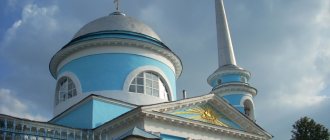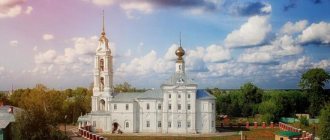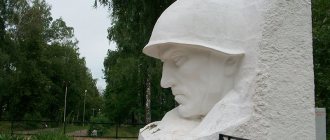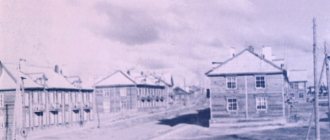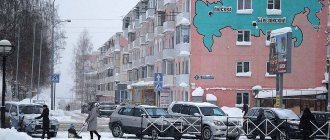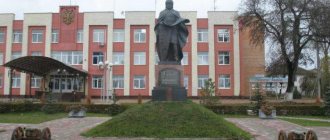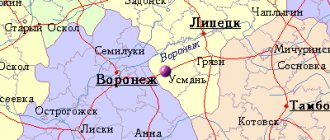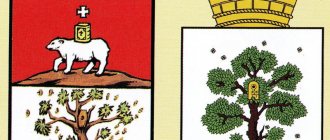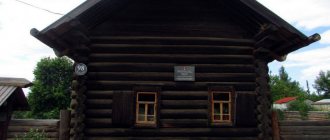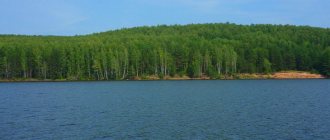A little history of the city of Oboyan
Information about the founding of Oboyan is scarce and contradictory. Various historical materials indicate different years, the Kursk land surveyor Ivan Bashilov in his “Description of the Kursk Governorate” for 1785 wrote that the city was founded in 1650, and the prosecutor Sergei Larionov points to 1651, there is information about the founding of the city in 1639.
The emergence of the city is associated with the defense of the southern borders of Rus' from the attack of nomads from the Wild Field. Robbery raids by the Crimean and Nogai Tatars took place almost every year.
The area where Oboyan is located has long been of great convenience for human life. The hill, washed by the rivers Psel and Boyan, surrounded by ravines and gullies, facilitated and strengthened defense against enemy attacks.
From the slope above the Psel River, endless distances opened up, and for centuries it, the river, was the natural border line of Rus', its shield against nomads. Before the construction of the fortress, there was a guard post on this hill, from which they monitored the Muravsky Way - the main road for raids of the Crimean Tatars .
The guards, unable to detain the enemy, turned to the Belgorod governor Pyotr Pozharsky with a request to build a fortification at this place. The construction of the fortress was preceded by a petition to the first Tsar of the Romanov dynasty, Mikhail Fedorovich. The content of the petition was as follows:
“Kursk and Belgorod residents, nobles and boyar children and Cossacks and archers and all sorts of service people are beating the foreheads of different cities. Merciful Sovereign, Tsar and Grand Duke of All Rus' Mikhail Fedorovich, perhaps we were ordered to build a city between Kursk and Belgorod on the halves from Kursk 60 versts and from Belgorod 60 versts, at the mouth of the Boyan River, otherwise the Boyanskoye settlement has always been about 10 versts from Muravskaya Sakma.
And as per your Sovereign’s decree, we attend your Sovereign service in the villages and villages, and on that long journey our brethren die and in the clearing we torment our belly hopelessly. And the Psel River comes to that Boyana settlement from the Russian side, there are arable fields between large forests, and we boyar children will have local lands in many strong places.” The note on the Belgorod voivode’s reply was as follows: “The sovereign ordered to send to the fort to inspect and draw a drawing.”
Modern planning structure of the Oboyansky district
The planning structure of the Oboyansky district developed historically - along the river planning axes. The main ones: r. The Psel and its tributaries remain the main axes of economic development of the region to this day. The main horizontal hydrographic axis is supported by two main transport arteries of the region: the Oboyan-Pristen railway line and the regional highways Sudzha-Oboyan and Oboyan-Solntsevo. That is, the main growth and concentration of the population occurs on the central latitudinal axis of the region.
Modern planning development is no longer based on the river, but on the transport framework of the territory. Since any production and residence, social security is connected, first of all, with transport accessibility. It is for this reason that a significant advantage in development has been given to precisely those settlements that combine the intersection of the axial lines of development of the historically established planning structure (according to hydrography) with the modern one.
Historically established settlements, oriented towards hydrography and not supported by good transport links, are rapidly losing population and becoming peripheral-recreational in importance.
Why Oboyan
D.N. Nikolsky in “Philosophical Notes” (issue 5, Voronezh, 1892) wrote: The inquisitive mind of the people strives to understand this or that name that is incomprehensible to them, and having found a suitable name with the help of their native language, they are completely satisfied with it ….this, for example, is the popular interpretation of “Oboyan” from two Yans (both Yans).
Historical documents have preserved not only the surnames, but also the names of the city’s builders, but there was not a single Jan among them. The settlement got its name from the Boyan River, on which it was built (near Boyan, hence Oboyan).
There is another version. In the magazine “History of the USSR” No. 3 for 1964, an article by S.A. Vysotsky “Inscription about the Boyanova Land in Sofia of Kyiv” was published. It said that when studying ancient inscriptions - graffiti of Sophia of Kyiv, records were found about the purchase of the land of Boyana by the wife of Prince Vsevolod. This name appears several times in “The Tale of Igor’s Campaign.”
“The Nightingale of the Old Time”, a famous songwriter, poet of Ancient Rus', Boyan, it turns out, was my fellow countryman, his patrimony was located on the site of the present city (this is officially evidenced by such toponyms as the Boyanka River and the Boyanskoe settlement).
But whether it was like this or not is now difficult to prove, you can only agree or look for another version. On August 1, 1639 (in other sources 1649) 600 servicemen arrived from Moscow, on foot and on carts, under the command of governor Ivan Koltovsky.
Already on August 16 of that year, a messenger was sent to Moscow with a report that on Spasov Day at the Oboyan settlement they sang a prayer service and, having blessed the water, “…two cities, three gates and six blind towers were founded between the river Boyanka and Krutoy Boyarka.”
The excellent climate of the central zone and its remarkable geographical location contributed to the construction of the city and the increase in its population. At the same time, construction was carried out on the Bogorodetsko-Znamensky Monastery, founded in 1663.
It was built on a hill, across a ravine from the fortress. According to some sources, there were endless litigations and disputes between them (the fortress and the monastery), which (in all likelihood) caused the fire in the monastery.
Subsequently, it was restored, and in 1730 there were two stone churches, reconstruction alternated with fires (the monastery burned three or even four times) and to this day, two two-story stone buildings have survived from the former monastery, which housed the middle church from 1943 to 1987. school No. 1 and two one-story buildings, where since 1943 there was a boarding school for deaf and mute children.
OBOYAN
OBOYAN, a city in Russia, in the south. parts of the Kursk region, the center of the Oboyansky district. Us. 13.6 thousand people (2012). Located on the right bank of the river. Psel, at the confluence of the river. Oboyanka. Railway station. The federal highway “Crimea” passes through O. (Moscow – Tula – Orel – Kursk – Belgorod – border with Ukraine).
Oboyan. Cathedral of St. Alexander Nevsky. 1891–1907. Architect V. G. Slesarev.
For the first time, a petition for the construction of a city on the site of the modern one. O. was submitted in 1638 by Kursk and Belgorod servicemen to Tsar Mikhail Fedorovich. O. was founded by decree of Tsar Alexei Mikhailovich dated 26.2 (8.3). 1649. Under hand Voivode I. N. Koltovsky 16 (26).8.1649 a tree was laid at the Oboyan settlement. fortress (construction completed in 1650). Service people from Orel and Kursk were transferred to O. Around the fortress arose traditional for southern Russian. cities, suburban settlements of service people (Streletskaya, Kazatskaya, Pushkarnaya). The emergence of O. contributed to the settlement of Upper Popselia. OK. 1663/64 Oboyansky Bogoroditsko-Znamensky men's monastery was founded. (closed in 1924, destroyed in the late 1940s - 1950s). In 1667 the Belgorod and Oboyan diocese was established (since 1787 Belgorod and Kursk). From the 2nd half. 17th century center of Oboyansky district. District city (1708–27) and provincial center (between 1708 and 1719) of Kyiv province, district city of Belgorod province. (1727–79), Kursk province. (1779–1924; until 1796 Kursk governorship). In the 18th–19th centuries. O., located on the main road from Moscow to Crimea, developed primarily as a trading center (the main items of trade were bread, livestock, salt, hemp, lard); residents also maintained inns, etc. In 1857 O. was connected by a highway with Kursk. In 1882, the Oboyan zemstvo built a narrow-gauge railway. village Maryino (now Rzhava) - Oboyan (in the mid-1930s, “changed” to broad gauge).
On Dec. 1917 installed owl. power. In 1918 several days (April 17–19) the city was under German control. troops. During the Civil War 1917–22 occupied on August 19, 1919 by units of the Armed Forces. forces of the South of Russia (VSYUR), 30.8.1919 - by the forces of the Red Army, 13.9.1919 again came under the control of the VSYUR. 11/26/1919 occupied by units of the Red Army during the counter-offensive of the South. front.
In 1924–28 O. was part of the Kursk district. Kursk province Regional center of the Kursk region. Central Chernozem region. (1928–30), Central Chernozem region. (1930–34), from 1934 Kursk region. In Vel. Otech. war occupied 11/16/1941 by Germany. troops. 4–10.1.1942 during fierce battles by troops of the right wing of the South-West. The front of the Red Army made unsuccessful attempts to liberate the city. Liberated on February 18, 1943 by troops of the Voronezh Front during the Voronezh-Kharkov offensive. operations. At the beginning of the Battle of Kursk 1943, Germany. The troops launched an attack on O., which was stopped south of the city during the defense. owl fights troops to the south face of the Kursk Bulge.
The city is divided into 2 parts by a small river. Oboyanka. East part of it was built according to a regular plan approved by the imp. Catherine II in 1784. Architect. The dominant features of the city are the monumental cathedrals - the Holy Trinity in the Russian style (1891–1908) and the 5-domed St. Alexander Nevsky in the neo-Byzantine style (1891–1907, architect V. G. Slesarev). Also preserved: the church in honor of the Smolensk Icon of the Mother of God (1790, rebuilt with the addition of chapels and a bell tower in 1845–49) and the ruined church. St. Elijah the Prophet (1841); former buildings spiritual school (early 1850s), district government (now the district administration), formerly women's gymnasium (1888; opened in 1892, now a pedagogical college), 2-story merchant houses 19 - early. 20th centuries In the style of owls. neoclassicism built railway. station, cinema "Russia" (1961). Local history specialist museum (founded in 1966, since 2002 a branch of the Kursk Regional Museum of Local Lore).
Factories: “Isoplit” (fibreboards, etc.; at the plant there is a greenhouse for growing citrus fruits and other subtropical crops), industrial rubber. "Technologist" products. Seed plant "Artel" (seeds of grain and leguminous crops). Elevator.
Near the city, in the village. Afanasyevo, - c. St. Nicholas in the style of classicism (1840); wood Church: Saints Cosmas and Damian in the village. Kosinovo (1801), Archangel Michael in the village. Trubezh (1868), Intercession of the Blessed Virgin Mary in the village. Kamenka (1893), St. Elijah the Prophet in the village. Polukotelnikovo (1895), Vmch. St. George the Victorious in the village. Dolzhenkovo (1900–08).
Sights of Oboyan
Every small town like this in Russia has its own attractions. In addition to ancient buildings that house various services, we have the Young Pioneers Park with the Memorial to those killed in the Great Patriotic War and the eternal flame.
Recently, a fountain began to function here, and there are attractions for children. The territory of the park is conducive to relaxation; you can often see parents and elderly people walking with their children. During the hot season, residents and guests of the city spend their free time in the shade of park alleys and flower beds, enjoying the beauty and peace.
Since 2022, a new beautiful square has appeared in the center of Oboyan, also, by the way, with a fountain. Even more charming in the evening, as the fountain and trees are illuminated, it has become one of the favorite places for walks and meetings.
In the city of Oboyan there are three existing churches: Smolenskaya, Holy Trinity and the Blessed Prince Alexander Nevsky Cathedrals; local residents, on a voluntary basis, are trying to restore the fourth - Ilyinskaya, located on a hill along Moskovskaya Street.
More than once the thought came to me - why in such a small town there are so many places for prayer, because if you believe the statements that churches were built in special places in ancient times, then there are already four such places in Oboyan.
There is an opinion among people that our town is a former settlement for the unreliable population of the capital, they say that all sorts of sorcerers and witchers were sent 600 km away, out of sight, and we are all their descendants. Here everyone chooses for themselves, for example, I don’t want to think that my ancestors are dark people, but who knows. I'm currently collecting my family tree, I wonder who my great-grandparents are.
It is noteworthy that until recently, some 20 years ago, the Smolensk Church was used for a long time as a warehouse for storing building materials. Such facts in our history surprise me very much. The city has preserved buildings dating back a century or more.
- The building of the inn of the Cheburashkin merchants (Kooperativnaya str., 3).
- Residential house of the merchant Abakumov (Lenin St., 3).
- Leather warehouse building (Lenin St., 14).
- Hotel Abakumov (Lenin St., 23).
- Residential building of confectioner Zubkov (Dzerzhinsky St., 25).
- The building of the women's gymnasium, now a teacher training college.
OBOYAN RUSSIA
There are settlements in Russia whose very names warm the soul. Kalach. Or Oboyan. Having found this name on the map of Russia, I decided to go there. Oboyan... An ancient town in the Russian outback, six hundred kilometers from Moscow. 13 thousand population. How do people live there now? If the megacities did not retain their enterprises, they were crushed by the steamroller of reforms, then how do these settlements survive? Where do people work? After all, the closure of even one enterprise in such towns threatens mass unemployment. In the predatory conditions of the market, has the charm of the province with its leisurely pace, hospitality, discouraging naivety, and pride in its corner been preserved?
To Kursk - by train. We arrive at 6 am. The most beautiful railway station: comfort, majesty and dignity of Stalinist architecture. Traditional procedure in modern realities: enter the station building through a metal detector. I go out to the square. The discomfort of a frosty dark morning, the faces of sleep-deprived people, the dirt of the surrounding area. Buses arrive one after another. The routes are very diverse, for example, “Kolobok-Kosukhino”. Everyone is leaving. We, a group of people who want to get to the bus station, are running in a crowd of impatience around the square from one arriving minibus to another in the hope that, finally, it’s ours. The excitement increases with each new potential passenger joining our ranks: we understand that there will not be enough space for everyone. Here is our transport. We rush to him, we are packed to the brim. We collect money and give it to the driver. He grumbles that there is an overload, let the extra ones come out: you can’t stand, they’ll fine you. We unanimously invite those standing to sit on the knees of those sitting. We managed to sit three at a time on seats that were designed for one and a half people, the chairs were so narrow. The compassionate driver returns money for those who are “extra,” saying that he doesn’t see with his back who and how. If they stop him, he doesn’t know anything, he has money for travel - according to the number of seats.
We drive past the majestic memorial to fallen soldiers. Nearby is a cemetery. It is surrounded by a metal fence, there are stars on it, and crosses behind the fence. You see crosses through the stars, on top of the stars.
In the minibus to Oboyan (55 kilometers of journey) the crowd is varied: a schoolboy, a student, elderly women, a young man, an old man... On the highway you understand why there are so many collisions of vehicles on the roads: only two lanes, from one settlement to another there are trucks, trucks - perhaps , the first samples of ZILs, they cannot reach speed. A tail of cars forms behind them, seizing any moment to overtake. And the road is either downhill or uphill, visibility is limited.
The intermediate point is the village of Medvenka. Square. Tiny pavilion of the bus station. There is a bench, on it there is an old man, apparently from the village, dozing, passing the time. The driver runs into the pavilion. And from there a voice is heard, announcing with a touch of officialdom: “The Kursk-Oboyan minibus has arrived at the Medvenka station. There is one free seat in the cabin. We ask those interested to take a seat.” Of the potential applicants, as the dispatcher clearly sees from his window, only this dozing old man, but he does not want to take a “seat” in the cabin. The driver runs out, and we set off with one empty seat.
The morning is gaining strength, the sun is shining with all its might. The azure of the sky, the emerald of the roadside landscape... A beautiful day.
And here is the sign “Oboyan”. We climb up a steep climb among one-story private houses with three or four windows. At the very top there is a bus station. On the opposite side is a majestic red brick temple. There are four of them in the city, and all are very good. I’m interested in the options for returning: to find out the schedule, I go to the bus station building, built in the 70s of the last century. Since its construction, it seems that the object has not seen the hands of a repairman. But this kind of dilapidation and beatenness of the steps is even nicer to me than the current European-quality plastic renovation. Passengers are greeted by the “Restoration of Pillows and Featherbeds” office. The second-hand corner is fenced off and sells flowers. Buffet, announcement: “New: fried pies. With liver - 7 rubles, with cabbage - 6 rubles, with potatoes - 6 rubles." I take the new one with cabbage. Somehow everything is homely: the barmaid scoops water from a bucket with a ladle and pours it into the kettle. When I take the tea, she asks if it’s hot or not. Not good. She pours half a glass and adds half a glass from a jar - chilled boiled water.
It’s Saturday afternoon, and the market located across the road is already in full swing. The goods are the same as everywhere else: Chinese consumer goods. At this or that tent, the seller, in addition to his goods - cheap stamped shoes, stationery, clothes - some put out a bucket of onions, some of apples. The city has a large private sector - 60% of the population lives there; houses have plots of land, usually 6 acres, where residents engage in gardening.
Two young saleswomen cuddle puppies, all of them, of any breed, are touching and, like all children, spontaneous. The puppies climb to lick their guardians, they laugh and offer to passers-by: “Let’s give it to good hands. Breed? Mom is a Pekingese, dad is for love.”
I go to the administration, which is located here on the square. But it’s a day off there. The square is very good, not every big city can boast of something like this: a wonderful cinema built in the 60s, with columns, bas-reliefs, and public gardens on both sides of the square. In one of them there is a monument to Lenin. Unfortunately, the park is poorly maintained. And it is overgrown with wild grass, through which flowers peek through. The honor board, to the credit of the local authorities, contains portraits of mostly working people.
I found that coziness and charm of small towns that Russian people cannot help but love in Oboyan: one- and two-story buildings, bushes, lawns, front gardens, wooden fences, gates, grandmothers on benches at the gates, birch and rowan trees under the windows... Low altitude buildings allows the light to roam. And in any sunshine there is radiance here.
I was pleasantly surprised by the politeness of the drivers: as soon as you step on a pedestrian crossing, they stop. This is understandable and achievable. According to police officers, traffic police officers are constantly on duty at intersections: both in official uniform and in civilian uniform. Violators are strictly fined. The crime rate (main offenses - theft, theft) in the area is actually decreasing. Compared to last year by 4.6%: from 259 crimes to 247. Prevention and educational work with schoolchildren help...
At first, the gloom of the narrow staircases, the creaking of floorboards, and muffled voices from the basement of the hotel - a former merchant's house where I decided to settle - alarmed me. And I was even curious: aren’t guests being slaughtered here at night? The simple-minded attendant reassured: “At night? No, no! Why at night? I understood from the tone that they weren’t cutting at all, but the answer might not have been reassuring. But the Internal Affairs Directorate completely reassured us: this year there was one murder - domestically motivated. I’ll say right away that I was very pleased with my stay in the old merchant’s house: I even liked the smell of some decay. And also small windows, a wall rug, a knitted tablecloth on the table, a reproduction of Perov’s painting “Hunters at Rest”... Look, the merchant from Kustodiev’s painting will appear on the threshold. True, the cat woke me up every now and then at night or early in the morning. The first meeting with her was a surprise. The room is on the second floor. I sat down at the table to write. Suddenly I feel someone looking at me through the window from the darkness. She turned her head: bulging eyes. It turns out there is an awning under the window. Then this guest often visited and, rising on her hind legs, either checked whether the window was open, or tried to open it.
In general, in Oboyan, pets can set an example for people whom Pushkin reproached for being lazy and incurious. The cats here are not uncurious, and the dogs are not lazy: from time to time, dogs near the hotel started barking. And the night did not let them sleep. And throughout the city, these guard brethren were engaged in chasing after one passer-by after another, until they were convinced that they did not make any impression on the traveler.
And you can rent a room in the city for 600 rubles a month, a luxurious one for 1,300 rubles.
How do people live in any city? They are working. They are studying. They are being treated. Whether they maintain order or not, take care of their appearance, spend their leisure time... I went through all the vital points for a person. I spent hours wandering the streets and alleys. The city, which was under occupation for 15 months during the war, was not greatly destroyed. Soviet troops bypassed it on both sides, and the Germans, fearing complete encirclement, came out without a fight. So many ancient buildings have been preserved. Among the residents are 12 Heroes of the Soviet Union, 3 full holders of the Order of Glory. Heroic people. And even now, many townspeople are heroes: Afghans and participants in combat operations in the Caucasus. There are 74 members of the military brotherhood, which is actively working in the city.
Suddenly an association with Leningrad was born: here, too, houses have their own appearance. There are many small stone one-story buildings, with masonry laid out in a special way, stone gates, platbands, and shutters. Geraniums and hydrangeas in the windows, tulle curtains. The gate gates are open, laundry is drying, bicycles and utensils are standing. The gardens have already been harvested. Lots of apple trees! On the streets, “bulky” apples lie underfoot.
In Soviet times, there was a huge fruit and vegetable state farm “Oboyansky”; there were 3 factories there. Including canned food. They rolled peas, made jam, squash caviar, dried mushrooms, apples, supplying them to the Far North. New times have come. Everything was destroyed! “One of the Moscow owners bought up the land. But things didn’t work out for him,” an elderly resident describes the economic situation. — There were vats made of food-grade aluminum, each holding 25 tons. They made jam. They sawed it into scrap and took it away. And so does the equipment.”
Nowadays there is a jam production plant. But the products are not distributed in the area. In stores from Oboyansky I was only able to buy bread: no milk, no cottage cheese, no sausage. There is peasant milk and cottage cheese on the market. They keep livestock even in the city, if anyone is on the outskirts.
The manufacturing industry has fallen under democracy and remains the same. There was a pig farm for 18 thousand heads, a repair plant, and a furniture factory. All this happened and floated out of the Oboyansky district and the city itself. Where do people work? In addition to school, hospital. Housing and communal services and other structures serving the population - on (“specializes in the production of fiberboards and their finishing with water-based paints and varnishes, panel furniture parts based on laminated fiberboard, paving slabs, lawn and curb stones, joinery, fans”). At AQUATONE (“is a manufacturer of PVC wall panels; PVC ceiling panels, plinths”).
“Isoplit” is proudly called city-forming. And 300 people work there. Others travel to Kursk, work in Moscow, and many work on the construction of the Voronezh Nuclear Power Plant. Families here are fathers in latrine trades. How can you live on the earnings here? The librarian has 4,600, 6,800 on hand. How do you manage to make ends meet? After all, you pay up to 4 thousand a month for gas alone in winter. Yes, it helps your garden. The prices here are completely inconsistent: bread - 14 rubles, potatoes at the market - 7-10 rubles, a bucket of apples - 100 rubles. But prices in stores are largely on par with those in Moscow. Some “House in the Village” - even in Oboyan - it’s still a little house at that price. You can buy a two-room apartment in a comfortable building for 700-800 thousand. Everything would be fine! But where to work? That's why they leave their homes. Whoever you ask, where are the children? In Kursk, Belgorod, Moscow...
And people don’t complain, don’t moan! We got used to it. With those whom I visited at work, I only talked about work: how many visitors are in the library, what they are interested in, what books are arriving. In the hospital: contingent, availability of medications. In the museum - what questions are mainly of interest to visitors, how many there are per year. At school: do students have a desire to study and continue it in the future? She didn’t touch politics at all, she wasn’t following it. And the people themselves did not touch it. And on the street you talk to anyone, they recognize you as a non-local and begin to scold the authorities, both local and central - they want to talk it out. The driver of the ride, having learned that I was a journalist from Moscow, cried out: “Yes, I will supply you with such material! A sensation throughout Russia! Our prosecutor's office is corrupt. The courts are corrupt. Everyone is corrupt!” I noticed that if the structures listed here were infallible, it would be a sensation.
I went to the hospital. They explain that they are here temporarily while their premises are being renovated. And it’s time for this building built in 1982, which is built on the pediment, to be updated. Dearest Lyudmila Nikolaevna Masalova, who after graduating from medical school returned home here and has been working as a therapist for decades, says that there are no specialized diseases in the area, people get sick just like everywhere else. Social illnesses have increased: diabetes mellitus, tuberculosis among a certain contingent. People are poorly nourished, do not receive vitamins, their bodies are weakened, and therefore are easily susceptible to diseases. No one is denied medical care, even if there is no insurance policy. The city lies on a federal highway, often on the way a person becomes ill and goes to the hospital. All necessary medicines are available. Treatment is free. And for some additional examinations, which are mostly done in Kursk, you have to pay.
But then I started talking to women who were sitting on a bench near the gate on a warm evening. They were treated in the hospital last winter: almost all the medicine was brought from home. The doctors said that they did not have it. By the way, at the pharmacy the saleswoman said that there are medicines that are absolute analogues. But people don’t buy ours for 12 rubles, but imported ones for 150, believing that it is more effective.
I walk past a hospital that is being renovated and there is a sign on the porch: “We demand decent wages.” Either the youth or the nurses are demanding. They say that when they began to recalculate the salaries of health workers according to the new rules, the nurses received payments in the amount of 2,600 rubles. Full time! And economists (“Why, tell me, should we save money at a clinic? The most accurate thing is the salary of these economists”) receive 35-50 thousand. That is, the main person in the hospital, as in the whole country, is the financier. So a therapist with more than 30 years of experience receives 6,800. Plus 8.400 is a recent profile supplement for therapists. How to live? Also a vegetable garden. Everyone holds on to the plot: “We plant a little of everything. So we’re fluttering around.”
There are also summer cottages. During Soviet times, people began to willingly take 6.15 acres. But now almost everything has been abandoned: even 10 km from the city is considered far here: gasoline, depreciation of the car. “You can’t dig up 15 acres under a shovel. Find a horse or tractor. What else will you get? I planted 10 buckets of potatoes, and dug up 2 buckets. The mole left. Just attacked. But our apple harvest is good. And berries: after strawberries, raspberries, cherries, and currants. They harvest well. But you can’t live on berries,” says a customer in the store.
“A lot of gypsies have arrived. You can buy a house for 50 thousand in the village. And they receive maternity capital: they will buy housing and a car with it. Marriages are not officially celebrated. They are considered single mothers and receive benefits. Does not work. There are no responsibilities, but all the rights.” Two gypsy sisters were imprisoned for distributing heroin. For the quiet Oboyan it was thunder: drugs. This is the mutual enrichment of peoples. We give them benefits and maternity capital, they give us thefts and drugs. In such a situation, sing at least as many songs about tolerance.
In a wonderful cinema, with a special, already forgotten atmosphere of a large hall (400 seats), I watched a film alone and by choice: if you bought 3 tickets, they held a screening. I bought tickets. Still, watching the big screen is a special feeling. And it’s surprising: neither in the cinema, nor in the cultural center, nor in libraries, nor on the playground of the city park, nor in the local history museum, nor at the stadium did I find anyone, either on a weekday or on weekends. And the streets are almost empty. And after six they die out.
In our country, no matter the library or the museum, there are the sweetest women enthusiasts everywhere. They are ready to tell you everything, show you everything, they are very proud of their exhibits, books, history, as if these are their personal achievements. In the local history department there are stands of a furniture factory, a repair plant... You can only see it in the museum. Oboyan is proud of his fellow countryman, physicist Vasily Vladimirovich Petrov, who discovered the electric arc. In the house where he used to live, there is now a city administration and a library college - a library technical school that was once famous in the Union.
The entrance to the administration building is free: there were no security guards, I didn’t meet anyone on the first floor. So the city leaders are within walking distance of the population. A conversation with the mayor of the city, Sergei Ivanovich Karelov, and his deputy, Gennady Aleksandrovich Apostolov, captivates them with their courtesy. They talk about success. Oboyan is praised (and for good reason - it’s a beautiful, cozy town). But the residents with whom I spoke on the streets, at the market, in shops, at the post office, scold the authorities. “They would like to get elected, steal, and think that they have done their job. You will ask who bought the housing and communal services, where the relatives are settled.” I haven’t heard a single kind word from people on the streets about the authorities. And not a single bad thing about the city itself. They love the city. They are proud of its former power and glory.
Kind and helpful heads believe that residents are always and everywhere unhappy, no matter how much you do for them. But even in the city center there are ruins of destroyed houses: there were emergency ones, they either fell on their own, or were demolished. People were resettled in new homes. And the ruins stand, not even fenced. Nearby there is a residential sector. How can children be allowed to go outside in such a neighborhood: either someone will drag them into the ruins, or they will fall into the basement themselves. Dirt on the streets. “It’s the residents who don’t clean up near their houses.” But who launched the city square, the bus station square, from which one begins to get acquainted with the city? The only bathhouse in the city has been closed for a long time... And this is everywhere in the country: the authorities believe that they are working hard, and the ungrateful population does not appreciate their efforts.
At the post office, a young girl operator shares what services Oboyans use: they send parcels (“there were as many as 8 of them this week”), they receive letters (mostly of an official nature). I wanted to call, but there is no telephone at the post office: go to the telegraph office. You can’t call the post office, but you can buy a set of pots, socks, or some small items.
Several hairdressers in the city. There is a “beauty and health salon”. How do Oboyan beauties shine? How much can they afford to spruce themselves up? 200 rubles for a haircut and 150 for a manicure. More expensive - no longer affordable. I ask: who are these clients who shell out 350 rubles once a week: teachers, doctors? The girl was amazed: “What are you talking about? Doctors and teachers do not have money for such procedures. They are getting their hair cut at the barbershop.” And here are officials and entrepreneurs.
Oboyan is a merchant city, and this trading vein has been preserved: some shops, kiosks, counters... According to Gennady Apostolov, Oboyan ranks third in the Kursk region in retail trade. But you can’t bargain with the salaries of local residents: for example, the average salary in the housing and communal services sector is 10,386 “dirty”. We have already talked about hospitals and libraries. Yes, and they sell imported goods.
The head teacher of Oboyan School No. 2, Marina Ivanovna Proskurina, enthusiastically talks about students, successes (50% of graduates enter universities on budget places), and events. He is perplexed: “Students ask: why now on TV even the announcers speak incorrectly? They don't seem to know about the placement of stress at all. Maybe that’s the way it is now?” What to say? If our TV stars went to a master class with Oboyan schoolchildren, they would give them the right speech.
I'm wondering where the local House of Culture is. They explain to me: go to the traffic light, then turn right. I go and look out, but I don’t see. It's already evening. It should be glowing, but no, it’s not visible, probably still far away. And I almost run into a traffic light pole. He does not work. For about six months now, they explain. But even then, every now and then I was directed by the traffic lights: when you get there, turn left. You get there, then another block... The guy calls someone on his cell phone: “I’ll be waiting for you at the traffic light.” Local landmark. Why doesn't it work? Probably because it's the same as most flashlights. The editor-in-chief of the local Oboyanskaya Gazeta, Leonid Yakovlevich Pilman, among other topics, touched upon the absurdity of the situation. All management organizations were transferred to Kursk. The district administration does not have the levers to control. And then the lamp in the street lamp burns out. After all, he didn’t stand on the chair and twist it. A tower is needed in addition to the light bulb itself. Then a letter is written to local power engineers, they go to Kursk, and then somewhere else. They give a sanction there. Follow the same chain - back: screw in the light bulb! Both time and money are wasted on all these formalities.
I left Oboyan, which really charms anyone, with a bucket of apples from the market, with a painting by local artist V. Matasov that simply enchanted me. And warmth in the soul. To the Psel River, to the hut houses, to the apple trees. There are still corners of my beloved Motherland where people have preserved their humanity, light in their souls, warmth, resistance to life’s circumstances, and a deep understanding of what is worth living and raising children for.
Subscribe to our channel in Yandex.Zen!
Click “Subscribe to channel” to read “Tomorrow” in the Yandex feed
City of Oboyan| Modern realities
The city-forming enterprise, CJSC Izoplite, produces chipboard (chipboard) and wood-fiberboard (fiberboard), the products are popular far beyond the borders of the region and even the region. There is also Aquaton LLC in the city, whose production bases carry out painting of the above-mentioned slabs and the production of plastic panels for decorative finishing, both internal and external premises.
Tekhnolog LLC has been operating quite long and stably, producing rubber products for production machines. A bakery that bakes more than a ton of bread and bakery products per day. By the way, it supplies bread not only to its own district, but also to the nearby Medvensky, and also supplies its products to the neighboring Belgorod region.
Of the agricultural enterprises, the most famous to me is Artel LLC, managed by the Antipov brothers. The economic guys, who are firmly on their feet, in addition to arable land and crops, are mastering more and more new areas of crop production and livestock farming, such as an orchard and a seed storage.
The district newspaper is often replete with information about the activities of these people; some agricultural shows and exercises are held on their basis, they allocate funds for the improvement of the city and the renovation of schools, and help in beautifying territories of various affiliations. Such philanthropists restored the dilapidated Smolensk Church, the oldest monument in our city, built in the 17th century.
In the city of Oboyan there are:
- four kindergartens;
- three city schools;
- children's sports school;
- children's art school;
- local history museum;
- three libraries, one of them for children;
- a pedagogical college that trains preschool workers;
- college of culture (former library technical school);
- two vocational and technical institutions under the same name - Agricultural College;
- There are a lot of different shops and supermarkets (magnets and fives).
This is probably the structural division of all small towns. In the future, I plan to dwell in more detail on some of the objects of my city, but for now, a general acquaintance.
Due to the fact that there is not enough work for the entire working population of the city, people are forced to work on construction sites in Moscow, at nearby Miratorg enterprises, and some travel to the regional center, 60 km away, to work.
There are more than 2,000 registered entrepreneurs in the area, many self-employed citizens providing construction and repair services to the population. Peasant farms (peasant farms) and large tenants of land shares operate in the fields of the district, paying dividends for their use.
General information about Oboyansky district
Oboyansky district is located in the southern part of the region, 67 km from the regional center.
It borders on Belovsky, Bolshesoldatsky, Medvensky and Pristensky districts. In the southern part it has a section of the border with the Belgorod region. The total area of the district is 1.026 thousand sq. km. The population of the district as of January 1, 2007, the permanent population was 31.9 thousand people. The territory of the Oboyansky district belongs to the southern agroclimatic region of the Kursk region with a temperate continental climate. The forest cover of the territory is 10.3%. The soil cover of the region is quite diverse. The main types of soils in the region are chernozems - 74% and gray forest soils - 24%, soils of other types account for 2%. According to the mechanical composition of the soil, heavy loamy - 91.9%, medium loamy - 6.4%, light loamy - 0.9%, clayey - 0.1%, sandy loam - 0.4%, sandy - 0.3%. Agricultural lands occupy 80.5% of the district's territory - 82,701 hectares, of which 28,936.81 hectares are arable land).
Mineral resources of the region - many large mineral deposits have not been identified to date; there are small deposits of clay, loam, silicate sand.
The district was formed in 1928. The length of the region from north to south is 45 km, from west to east – 55 km. The area of the district is 1.026 thousand square meters. km, which is 4% of the region's territory. Oboyansky district borders in the west with Belovsky and Bolshesoldatsky, in the north - with Medvensky, in the east - with Pristensky districts of the Kursk region, and in the south - with the Belgorod region of Russia. As of January 1, 2007, 31.9 thousand people lived in the district, including 13.7 thousand people living in urban areas. Among rural settlements, settlements with a population of 100 to 500 people predominate - 41%. Population density – 31 people/sq.km.
conclusions
Of course, this is a very short story about the city of Oboyan, but in order not to bore you, I will minimize my story. The city continues to live its own life, time flies quickly, new houses are built, new streets appear. Now, in the city center, as part of the housing improvement program, old buildings are being demolished, and modern buildings are quickly “grow” in their place.
The facades of familiar buildings are being transformed, and shops are attracting attention with tickers and bright signs. The Rossiya cinema has recently become a worthy place of leisure, and city residents enjoy visiting it.
Sometimes even all tickets for evening shows are sold out, especially for premieres. The ability to watch movies in 3D format has opened up new horizons for this cultural institution.
The idea of raising children and behavior in public places is changing. What was not acceptable in my childhood is now the norm. The habit of some parents to send their children to school by taxi never ceases to amaze me. Fortunately, this service is available in abundance in Oboyan, although from the words of some mothers I learned that in the morning sometimes there are not enough cars for everyone.
Remembering my childhood, it becomes funny, because I went to first grade at school with my dad, he worked next to the school in the traffic service and it was on his way to walk me to the door. But this was only at the beginning of the school year, then I began to run away from him to my girlfriends, whom I met not far from home, and we went to school together, discussing lessons or some of our affairs.
It was an opportunity to get closer to each other and make friends. They returned home in the same way. But to each his own. I hope my story was interesting, and you took a tour around Oboyan. Please write in the comments if you are familiar with life in small towns, is it interesting to you?
